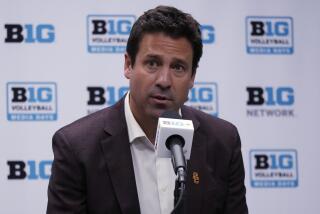L.A. UNIVERSITY BEAT / WENDY WITHERSPOON : Non-Revenue Sports Seek Ways to Survive
- Share via
The curtain may have fallen on seven non-revenue sports in the Big West, Pacific 10 and Western Athletic conferences during the 1991-1992 academic year.
The Mountain Pacific Sports Federation, which is scheduled to begin competition in the fall, would unite the sports from the three conferences to try to preserve competition and control costs.
Affected would be men’s water polo, men’s soccer, wrestling, men’s gymnastics, men’s and women’s indoor track and men’s volleyball. The federation may include women’s soccer in 1993.
The Big West and the WAC have approved the federation, but approval by the Pac-10 is pending. Pac-10 representatives will meet this week for further discussions.
Men’s soccer, which begins in September, already has its federation schedule and championship structure in place. Sixteen teams are scheduled to participate in two divisions, and the winner of the federation championship will receive an automatic berth to the 1992 NCAA Division I tournament.
“Playing in a conference adds a little bit of attractiveness to the games and makes it more exciting for the players,” UCLA Coach Sigi Schmid said. The Bruins, who won the NCAA championship in 1990, never have had a conference affiliation because the Pac-10 did not sponsor soccer.
It is uncertain, however, what will happen to the five Pac-10 soccer teams if the Pac-10 votes against the new federation this week, according to Chris Hoyles, a Pac-10 assistant commissioner.
Water polo, the other sport scheduled to begin in the fall, will name a champion from the highest placing of the nine federation teams at the Cal State Long Beach tournament, Oct. 24-25. The champion will receive the federation’s automatic bid to the 1992 NCAA championships.
Water polo coaches at first rejected the idea of joining the federation.
“Initially, we thought that having . . . two separate conferences was great. To put them all in the same conference didn’t make sense. It would be like putting all your top football teams in the same conference,” said Ken Lindgren, the Cal State Long Beach water polo coach for 17 years.
The top five finishers at the 1991 NCAA water polo championships were all Big West and Pac-10 teams.
Even though only four schools play water polo in the Pac-10, they are national powers.
“(The Pac-10) being such a strong conference, with a lot of tradition, it’s going to hurt to lose it,” Steve Heaston, coach of defending NCAA champion California, said. “But at the same time . . . maintaining the sport is more important than some of the emotional issues that we wrestled with initially.”
Water polo has become a target in athletic departments’ efforts to trim budgets. The Fresno State water polo program was dropped last week.
Pac-10 representatives have said they hesitated approving the federation because of such issues as governance and eligibility. Administration of the sports would be divided among the three conferences. Eligibility would be handled by each school’s conference, and the NCAA transfer rule would be used.
But some issues that have caused the three conferences problems in organizing the federation are less tangible.
“I think it’s a real test to see how we can all get along, to tell you the truth,” said Dr. Judith Holland, senior associate athletic director at UCLA.
Water polo and men’s gymnastics are in peril of having their NCAA championship status revoked because of declining participation. Over the years, the number of men’s gymnastics programs has fallen from 71 to 41, and men’s water polo dropped from 54 to 48.
A sport must be sponsored by 7%--or 58--of the NCAA member schools to maintain championship status. If nothing is done to save their championships, 1993 will be the last year for men’s water polo and 1994 will be the last for men’s gymnastics.
If the NCAA drops the sports, schools might follow suit.
Cutting water polo, however, could affect the U.S. Olympic team.
“The NCAA has somehow got to find a way to help protect all of our Olympic sports,” said Lindgren, who has worked with the U.S. national team since 1977. “If you take the NCAAs out of there, all of the development for some of these amateur sports is gone.”
The Pac-10 won nine NCAA team championships, five men’s and four women’s, as well as Washington’s national title in football, the most of any league during the 1991-92 academic year. The Southeastern Conference was the next most prolific, with six--three men’s and three women’s.
Stanford’s five team titles--men’s and women’s swimming, women’s basketball, men’s gymnastics and men’s tennis--was the most of any school. After Arkansas, which won three, UCLA, Pepperdine and Florida each won two.
Pepperdine’s championships were in men’s volleyball and baseball. UCLA’s were in women’s volleyball and women’s softball.
This is a twice-monthly column focusing on non-revenue Division I sports at UCLA, USC, Pepperdine, Cal State Long Beach and Loyola Marymount. It will be in hiatus for the summer and resume in the fall.
More to Read
Go beyond the scoreboard
Get the latest on L.A.'s teams in the daily Sports Report newsletter.
You may occasionally receive promotional content from the Los Angeles Times.






